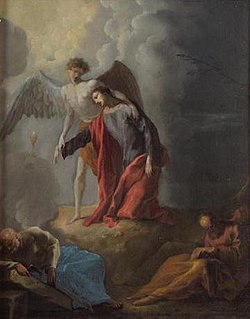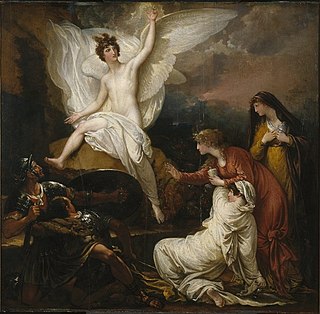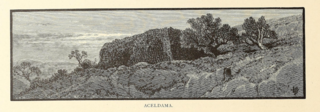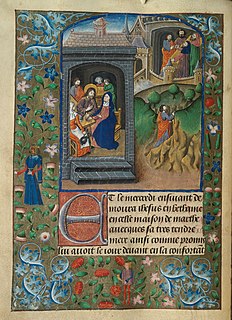
Matthew 4:5 is the fifth verse of the fourth chapter of the Gospel of Matthew in the New Testament. Jesus has just rebuffed Satan's first temptation in this verse the devil transports him to the site of the second temptation.

Matthew 5:1 and Matthew 5:2 are the first two verses of the fifth chapter of the Gospel of Matthew in the New Testament. The verses introduce the Sermon on the Mount that will be recited in the next several chapters. The previous verse mentioned the large crowds "from Galilee, and from the Decapolis, Jerusalem, Judea, and beyond the Jordan" who followed Jesus to witness him healing: these verses present Jesus as seeing the crowds and going up onto a mountain to begin teaching.

Matthew 5:22 is the twenty-second verse of the fifth chapter of the Gospel of Matthew in the New Testament and is part of the Sermon on the Mount. It is the first of what have traditionally been known as the 6 Antitheses. In this one, Jesus compares the current interpretation of "You shall not murder" from the Ten Commandments with his own interpretation.

Matthew 5:26 is the twenty-sixth verse of the fifth chapter of the Gospel of Matthew in the New Testament and is part of the Sermon on the Mount. Jesus has just warned that if you do not reconcile with your enemies a judge is likely to throw you in jail. In this verse Jesus mentions that your debts must be paid completely before one can leave.

Matthew 7:16 is the sixteenth verse of the seventh chapter of the Gospel of Matthew in the New Testament and is part of the Sermon on the Mount. This verse continues the section warning against false prophets.

Matthew 27:3 is the third verse of the twenty-seventh chapter of the Gospel of Matthew in the New Testament. This verse returns to the story of Judas Iscariot who, in the previous chapter, had accepted payment to betray Jesus to the Jewish authorities. This verse opens the story of his remorse and death.

Matthew 28:1 is the first verse of the twenty-eighth chapter of the Gospel of Matthew in the New Testament. This verse opens the resurrection narrative as Mary Magdalene and "the other Mary" visit Jesus' tomb after the crucifixion.

Matthew 28:4 is the fourth verse of the twenty-eighth chapter of the Gospel of Matthew in the New Testament. This verse is part of the resurrection narrative; describing the reaction of the tomb guards after the arrival of the angel of the Lord and the occurrence of an earthquake that opened the tomb.

Matthew 28:2 is the second verse of the twenty-eighth chapter of the Gospel of Matthew in the New Testament. This verse is part of the resurrection narrative. Mary Magdalene and "the other Mary" were approaching Jesus' tomb after the crucifixion, when an earthquake occurred and an angel appeared.

Matthew 28:5–6 are the fifth and sixth verses of the twenty-eighth chapter of the Gospel of Matthew in the New Testament of Christian Bible. This verse is part of the resurrection narrative. An angel has appeared at the empty tomb and in this verse he gives instructions to Mary Magdalene and "the other Mary".

Matthew 28:7 is the seventh verse of the twenty-eighth chapter of the Gospel of Matthew in the New Testament. This verse is part of the resurrection narrative. An angel has appeared at the empty tomb and in this verse he continues his instructions to Mary Magdalene and "the other Mary".

Matthew 28:9 is the ninth verse of the twenty-eighth chapter of the Gospel of Matthew in the New Testament. This verse is part of the resurrection narrative. Mary Magdalene and "the other Mary" are leaving the empty tomb of Jesus after encountering an angel, and in this verse they encounter the risen Jesus.

Matthew 28:10 is the tenth verse of the twenty-eighth chapter in the Gospel of Matthew in the New Testament. This verse is part of the resurrection narrative. Mary Magdalene and "the other Mary" are leaving the empty tomb of Jesus after encountering an angel, and in this verse they encounter the risen Jesus.
Matthew 28:11 is the eleventh verse of the twenty-eighth chapter of the Gospel of Matthew in the New Testament. This verse is part of the resurrection narrative. In this verse the guards of the tomb, after being present for an angel hearkening the resurrection, return to report to Jerusalem.
Matthew 28:12 is the twelfth verse of the twenty-eighth chapter of the Gospel of Matthew in the New Testament. This verse is part of the resurrection narrative. In this verse the guards of the tomb, after being present for an angel hearkening the resurrection, are bribed by the priests to lie about what they saw.

Matthew 27:11 is the eleventh verse of the twenty-seventh chapter of the Gospel of Matthew in the New Testament. This verse brings the narrative back to Pilate's Court, and the final trial of Jesus.

Matthew 27:7 is the seventh verse of the twenty-seventh chapter of the Gospel of Matthew in the New Testament. This verse continues the final story of Judas Iscariot. In the previous verses Judas has killed himself, but not before casting the thirty pieces of silver into the Temple. In this verse the priests decide to buy a potter's field with them.

Matthew 27:2 is the second verse of the twenty-seventh chapter of the twenty-seventh chapter of the Gospel of Matthew in the New Testament. Jesus has just been condemned by the Jewish Sanhedrin, and in this verse is presented to Pontius Pilate.

Matthew 27:6 is the sixth verse of the twenty-seventh chapter of the Gospel of Matthew in the New Testament. This verse continues the final story of Judas Iscariot. In the previous verse Judas had cast into the temple the thirty pieces of silver he'd been paid for betraying Jesus. In this verse the priests discuss what to do with them.
Matthew 27:9-10 are the ninth and tenth verses of the twenty-seventh chapter of the Gospel of Matthew in the New Testament. These verses end the final story of Judas Iscariot, with a quotation from scripture showing how the events around his final days were predicted.

















